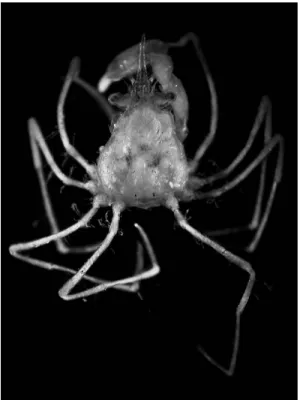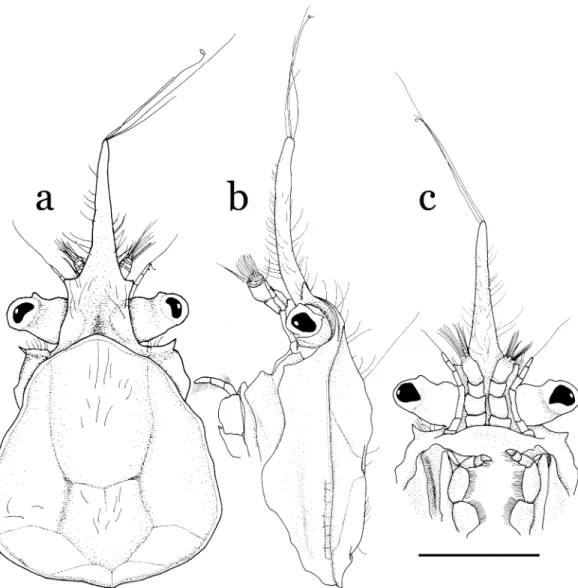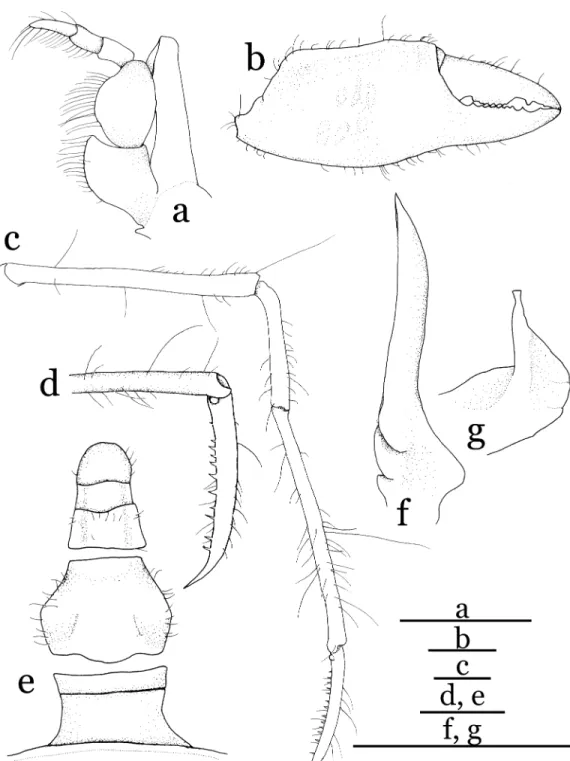False spider crabs of the family Hymenoso- matidae mainly occur in shallow marine coastal habitats of tropical to temperate regions in the Indo-West Pacific, although some species also occur in freshwater, and some extend their distri- butions to sub-Antarctic areas (Lucas, 1980;
Chuang and Ng, 1994). Among 111 known hy- menosomatid species (Ng et al., 2008; Naruse et al., 2008), twelve species have been recorded from Japan (Nakasone and Takeda, 1994; Sakai, 2004; Naruse et al., 2005), however, there is little doubt that this has been underestimated. In this study, we describe a new species provisionally assigned to HalicarcinusWhite, 1846 based on a single male specimen collected at a small port in Ginowan, Okinawa Island, Ryukyu Islands. A brief review on the taxonomy of the genus is also presented.
Specimens examined are deposited in the Na- tional Museum of Nature and Science, Tokyo (NSMT); the Natural History Museum and Insti- tute, Chiba (CBM); the Osaka Museum of Natural History, Osaka (OMNH); Zoological Laboratory, Kyushu University, Fukuoka, Japan (ZLKU)
(specimens that have been transferred to the Kita- kyushu Museum of Natural History and Human History, Fukuoka, Japan); and the Zoological Reference Collection of the Raffles Museum of Biodiversity Research, National University of Singapore (ZRC). The terminology essentially follows Ng and Chuang (1996) and Guinot and Richer de Forges (1997). Measurements provided are of the carapace length (measured along the midline from the posterior margin to the anterior margin of the hymenosomian groove) by the carapace width (measured across the widest point).
The total length indicates a sum of the carapace and rostral lengths.
For comparative purposes, the following speci- mens were examined.
Halicarcinus bedfordiMontgomery, 1931: ZRC 2002.0605, 2 males (2.83.2, 3.13.6 mm), 2 ovigerous females (2.83.1, 3.13.4 mm), Irian Jaya, Indonesia, coll. 11 September 1997; ZRC 2002.0606, 1 male (2.53.0 mm), 1 female (2.8 3.2 mm), Ajkwa Island, Irian Jaya, Indonesia, coll. 12 June 2001.
Halicarcinus coralicola(Rathbun, 1909): ZRC
A New Species of the False Spider Crab Genus Halicarcinus (Decapoda:
Brachyura: Hymenosomatidae) from Okinawa Island, Japan
Tohru Naruse1,2and Tomoyuki Komai3
1Raffles Museum of Biodiversity Research, Department of Biological Sciences, National University of Singapore, 14 Science Drive 4, Singapore 117543, Republic of Singapore
2Present address: Transdisciplinary Research Organization for Subtropical and Island Studies, University of the Ryukyus, 1 Senbaru, Nishihara, Okinawa, 903–0213 Japan
e-mail: naruse@lab.u-ryukyu.ac.jp
3Natural History Museum and Institute, Chiba, 955–2 Aoba-cho, Chuo-ku, Chiba, 260–8682 Japan e-mail: komai@chiba-muse.or.jp
Abstract A new species of the hymenosomatid crab genus Halicarcinus White, 1846, H.
ginowan sp. nov., is described based on a single male specimen from Okinawa Island, Ryukyu Islands, Japan. The new species is morphologically similar to H. keijibabaiTakeda and Miyake, 1971, however they are clearly distinguished by the structure of the rostrum, and the shape of the male chelipeds. The taxonomy of Halicarcinusis reviewed and is evidence that it is polyphyletic.
Key words : Decapoda, Brachyura, Hymenosomatidae, Halicarcinus, new species, Ryukyu Islands, Japan.
1989.3552–3576, 8 males (1.71.6 to 2.02.2 mm), 16 ovigerous females (1.82.1 to 2.42.5 mm), 1 female (1.71.8 mm), Labrador Beach, Singapore, coll. P. K. L. Ng, 14 December 1989;
NSMT-Cr 10410, 1 male (3.33.8 mm), Abura- tsubo, west coast of Miura Peninsula, Sagami Bay, Japan, coll. N. Shikatani; ZRC 1994.4232, 1 male (2.72.9 mm), Yamada, Ishikawa, Oki- nawa, Japan, coll. T. Kosuge, 18 February 1992;
ZRC 1994.4239, 4 males (2.22.2 to 3.03.5 mm), Miyara, Ishigaki Island, Ryukyu Islands, Japan, coll. T. Kosuge, 23 March 1993.
Halicarcinus keijibabai (Takeda and Miyake, 1971): ZLKU, holotype, male (2.02.0 mm), Plum, New Caledonia, coll. K. Baba, 9 June 1968; ZRC 1994.4283, 1 male (1.62.0 mm), Marée à Ouemo, Nouméa, New Caledonia, inter- tidal, coll. B. Richer de Forges, 2 July 1992;
ZRC, 2 males (1.61.7, 1.82.0 mm), 1 female (2.22.4 mm), Ricaudy Reef, New Caledonia, coll. P. Bouchet, 10 April 1993.
Halicarcinus messor(Stimpson, 1858): OMNH- Ar. 7656, 1 male (4.55.1 mm), Nagasaki Coast, Misaki, Sennan, Osaka Prefecture, Japan, coll. Y.
Shibata, 15 May 1960; OMNH-Ar. 7657, 1 male (5.16.3 mm), Mukaijima, Mitsugi-gun, Hiro- shima Prefecture, Japan, coll. A. Inaba, July 1976; OMNH-Ar. 7658, 1 male (3.74.2 mm), 1 female (2.73.3 mm), Nagasaki Coast, Misaki, Sennan, Osaka Prefecture, Japan; OMNH-Ar.
7659, 1 male (4.65.4 mm), Takino-chaya, Taru- mi, Kobe, Hyogo Prefecture, Japan, coll. Y. Shi- bata, 13 May 1960.
Halicarcinus orientalis Sakai, 1932: ZRC 1994.4247, 1 male (1.72.2 mm), 2 females (1.52.0, 1.82.1 mm), Kisami, Izu Peninsula, Shizuoka Prefecture, Japan, 33–41 m, coll. K.
Nakamura.
Halicarcinus ovatus Stimpson, 1858: ZRC 1993.6518–6519, 1 male (4.44.9 mm), 1 ovigerous female (4.24.8 mm), Durras, New South Wales, Australia, coll. M. Takeda, 1 April 1997.
Halicarcinus setirostris (Stimpson, 1858):
ZRC 1999.1223, 1 male (1.62.0 mm), East China Sea, on fine sand, 135 m, 28 August 1976; ZRC
1999.1224, 1 ovigerous female (3.13.4 mm), Jiao-Jhou Wan, Qingdao, China, on sand and broken shells, 25 m, 15 September 1980.
Taxonomy
Family Hymenosomatidae Genus HalicarcinusWhite, 1846
Halicarcinus ginowansp. nov.
[New Japanese name: Ginowan-yawara-gani]
(Figs. 1–3)
Material examined. Holotype: NSMT-Cr 19742, male (2.11.9 mm), small fishing port nearby Ginowan Marina, Okinawa Island, Ryukyu Islands, Japan, 2–3 m, mooring rope, coll. T.
Komai, 18 March 2006.
Description of holotype. Carapace, including rostrum, elongate triangular in shape, total length 1.91 times carapace width (Figs. 1, 2a). Rostrum
176 T. Naruse and T. Komai
Fig. 1. Halicarcinus ginowansp. nov. Holotype, male (2.11.9 mm), NSMT-Cr 19742, entire animal in dorsal view.
(Fig. 2a–c) slender, elongate, 0.73 times as long as carapace, tapering distally, demarcated from carapace by hymenosomian groove, principally trilobed; lateral lobes small, triangular, situated at about proximal one-third of rostrum; lateral mar- gins above eyestalk only slightly diverging poste- riorly in dorsal view, notably arched in lateral view, forming narrow supraocular eave; rostral tip subacute, with tuft of long setae (longest setae only slightly shorter than rostrum). Carapace (Fig. 2a–c) with hymenosomian groove, regions clearly demarcated by gastro-cardiac, cervical
and thoracic grooves; gastric and branchial regions convex; hymenosomian groove and epimeron lacking teeth or lobes; subhepatic region weakly inflated, visible in dorsal view, an- teriorly continuous with supraocular eave, bear- ing small lobe on posterolateral margin, antero- lateral angle terminating acutely. Orbit incom- plete, ventral part basal to eyestalk without crista or demarcation.
Epistome (Fig. 2c) long; posterior margin with rounded, deflexed median lobe. Lateral margin of buccal cavern upturned, forming keel.
Fig. 2. Halicarcinus ginowansp. nov. Holotype, male (2.11.9 mm), NSMT-Cr 19742. a, cephalothorax, dorsal view; b, cephalothorax, lateral view; c, anterior part of cephalothorax, ventral view. Scale bar: 1 mm.
Eyestalk (Fig. 2a-c) directed laterally, slightly constricted submedially, anteriorly with small tu- bercle proximal to base of cornea; cornea nar- rower than eyestalk. Antennule (Fig. 2b, c) with relatively stout basal article. Antennal peduncle (Fig. 2b, c) slender, six-segmented, arising pos- terolateral to base of eyestalk, second to fifth seg- ments not fused to cephalon, not developed into infraorbital margin.
Third maxillipeds (Figs. 2c, 3a) covering more than two-thirds of buccal cavern when closed.
Ischium as long as merus, distomesial angle pro- duced. Merus ovoid in shape. Mesial margins of ischium and merus with row of long stiff setae.
Exopod stout, about two-thirds of ischium, reaching beyond distal margin of merus, bearing long flagellum.
Thoracic cavity without delineation of anterior border; lateral side raised between levels of ante- rior third of coxa of cheliped to posterior end of coxa of second pereopod; penis arising at level of posterior margin of coxa of third pereopod.
Right cheliped (Figs. 1, 3b), somewhat elon- gate, but relatively stout. Merus elliptical in cross-section, weakly curving inwards. Carpus about 1.5 times longer than merus, broadened distally, dorsodistal inner angle and ventrodistal outer angle clearly delineated. Chela slightly longer than carapace; palm slightly inflated in general, but outer and inner surfaces with shal- low depressions, slightly carinate dorsally; fin- gers slightly longer than half length of palm, im- movable finger with small triangular teeth; dacty- lus with molar-like tooth medially. Left cheliped missing. Ambulatory legs (second to fifth pere- opods) (Figs. 1, 3c) slender, very long, decreas- ing in length posteriorly; combined length of merus to dactylus of second pereopod 3.29 times carapace length, merus of second pereopod 1.12 times carapace length. Meri and carpi cylindrical in cross-section. Propodi as long as respective meri, slightly broadened distally; dactylo-propo- dal articulation of each leg forming specialized locking mechanism consisting of distoflexor semicircular extensions with distoextensor con- cavity of propodus and basal tubercle on either
side of dactylus (Fig. 3d). Dactyli (Fig. 3d) com- pressed dorsoventrally, about half-length of re- spective propodi, terminating in slender, sharp claws, each with 11–15 small teeth on flexor sur- face.
Abdomen (Fig. 3e) 5-segmented with third and fourth segments completely fused; first segment longer than second segment, with concave lateral margins; third-fourth fused segment with convex lateral margins, widest at proximal two-fifths;
fifth segment, sixth segment and telson demarcat- ed by thin sutures on outer surface.
First gonopod (Fig. 3f) simple, tapering distal- ly, weakly curved mesially, with single thin groove extending from ventroproximal part through mesial margin to distal end. Second gonopod (Fig. 3g) small, proximal outer and inner regions membranous, distal part tube-like.
Distribution. Known only from Ginowan, Okinawa Island, Ryukyus, 2–3 m.
Habitat. The holotype was attached to a mooring rope covered with fine mud.
Remarks. During this study, we briefly re- viewed species presently referred to Halicarcinus for comparative purposes. Sakai (1938) distin- guished Halicarcinus from Rhynchoplax Stimp- son, 1858, by its short median robe of the ros- trum and relatively stout male cheliped. Lucas (1980), however, considered these characters to be too variable, and he regarded Rhynchoplaxas a junior synonym of Halicarcinus. Lucas (1980) characterized Halicarcinusby the possession of a hymenosomian groove separating the base of the rostrum from the carapace, the presence of a well-developed epistome, the relatively broad third maxilliped, and the presence of rows of teeth on the flexor margins of the ambulatory dactyli. The genus now contains 21 species, in- cluding H. ginowan sp. nov. After comparisons of several Halicarcinus species based on speci- mens and literature, we found that four groups can be recognized within the genus. The first group includes eight species, viz., H. cookii Fil- hol, 1885, H. innominatusRichardson, 1949, H.
orientalis Sakai, 1932, H. ovatus Stimpson, 1858, H. planatus (Fabricius, 1775) (the type
178 T. Naruse and T. Komai
Fig. 3. Halicarcinus ginowansp. nov. Holotype, male (2.11.9 mm), NSMT-Cr 19742. a, left third maxilliped, outer view; b, right chela, outer view; c, right second pereopod, outer view; d, dactylo-propodal articulation of right third pereopod, outer view; e, abdomen and telson, outer view; f, first gonopod; g, second gonopod.
Scale bars: 0.5 mm.
species of the genus), H. tongiMelrose, 1975, H.
varius (Dana, 1851), and H. whitei (Miers, 1876), and is united by the following features:
(1) rostrum short, trilobate with prominent lateral lobes; (2) chelipeds not markedly elongate in males; (3) distal part of male first gonopod thin, markedly curved; and (4) dactylo-propodal artic- ulations of ambulatory legs not modified (Gor- don, 1940; Garth, 1958; Melrose, 1975; present study).
The second group, including three species, H.
keijibabai(Takeda and Miyake, 1971), H. corali- cola(Rathbun, 1909), and H. ginowansp. nov., is characterized as follows: (1) rostrum trilobed, but median lobe greatly elongate and lateral lobes small or rudimentary; (2) chelipeds moderately to noticeably elongate in males; (3) male first gonopod gradually tapering distally to slightly curved distal part (as seen in Neorhynchoplax species); and (4) dactylo-propodal articulations of ambulatory legs strongly modified, forming specialized locking mechanism (Takeda and Miyake, 1971; Ng and Chuang, 1996; present study).
The third group, containing three species, H. messor (Stimpson, 1858), H. hondai(Takeda and Miyake, 1971) and H. setirostris(Stimpson, 1858), is characterized by the following features:
(1) rostrum long, unilobate, compressed dorsoven- trally; (2) chelipeds only moderately elongate in male; (3) distal part of male first gonopod notice- ably bent outward proximally; and (4) dactylo- propodal articulations of ambulatory legs not modified (Takeda and Miyake, 1971; Lucas, 1980; Sakai, 1976; Dai and Yang, 1991; present study).
The fourth group is monospecific, containing only Halicarcinus bedfordi Montgomery, 1931.
This species possesses the following characters:
(1) rostrum unilobate, triangular; (2) chelipeds moderately elongate in male; (3) male first gono- pod very stout, straight (as seen in Amarinus species); (4) dactylo-propodal articulations of ambulatory legs strongly modified into a special- ized locking mechanism (Montgomery, 1931;
Lucas, 1980; present study).
Lucas (1980) considered that the characters we have used to define these groupings tended to be too variable among species to be useful for generic separation, but to us the present group- ings seem quite clear. Future studies may reveal that these four grouping deserve generic ranking.
Halicarcinus ginowan sp. nov. is morphologi- cally most similar to H. keijibabaiin their gener- al shape of the carapace. Takeda and Miyake (1971) did not recognize dorsal grooves other than H-shaped groove in H. keijibabai, but our careful reexamination of the holotype revealed that H. ginowan and H. keijibabai even share similar dorsal grooves. However, H. ginowan can be immediately distinguished from H. kei- jibabai by the proportionally longer rostrum (0.73 times as long as the carapace versus less than 0.50 times as long) and the laterally directed eyestalk (versus directed anterolaterally in H. kei- jibabai). In the new species, the eyestalks are attached ventral to the subparallel supraocular eaves, which makes the eyestalk stick-out lateral- ly. In contrast, the eyestalks of H. keijibabaiare attached ventral to the strongly divergent proxi- mal margins of the rostral base, and thus the eye- stalks are directed anterolaterally. Furthermore, the male cheliped appears less elongate in the new species than in H. keijibabai. Halicarcinus ginowanis readily distinguished from H. corali- colaby its much longer rostrum, the lack of mar- ginal anterolateral teeth on the carapace, the much more elongate ambulatory legs, the palm of the male chela being less elongate, and the op- posable margins of the fingers of H. ginowan not forming a broad hiatus as they do in H. coralicola.
Etymology. This new species is named after the type locality, Ginowan, Okinawa Island. Used as a noun in apposition.
Acknowledgments
We thank Bertrand Richer de Forges (Institut de Recherche pour le Développement, Nouméa) and Peter J. F. Davie (Queensland Museum) for reviewing this manuscript. The first author also thanks Peter K. L. Ng (Raffles Museum of Biodi-
180 T. Naruse and T. Komai
versity Research, National University of Singa- pore), So Ishida (Osaka Museum of Natural His- tory), and Michitaka Shimomura (Kitakyushu Museum of Natural History and Human History) for providing him with museum facilities.
References
Dai, A. and S. Yang. 1991. Crabs of the China Seas.
iv608 pp., 74 pls. China Ocean Press, Beijing, and Springer-Verlag, Berlin, Heidelberg, New York, Tokyo.
Garth, J. S. 1958. Brachyura of the Pacific Coast of Amer- ica. Allan Hancock Pacific Expeditions, 21: i–xii, 1–
804.
Gordon, I. 1940. On some species of the genus Elamena (s.s.) (Crustacea, Decapoda). Proceedings of the Lin- nean Society of London, 152: 60–78.
Guinot, D. and B. Richer de Forgés. 1997. Affinites entre les Hymenosomatidae MacLeay, 1838 et les Inachoidi- dae Dana, 1851 (Crustacea, Decapoda, Brachyura).
Zoosystema, 19: 453–502.
Lucas, J. S., 1980. Spider crabs of the family Hymenoso- matidae (Crustacea: Brachyura) with particular refer- ence to Australian species: systematics and biology.
Records of the Australian Museum, 33: 148–247.
Melrose, M. J. 1975. The marine fauna of New Zealand:
family Hymenosomatidae (Crustacea, Decapoda, Brachyura). New Zealand Oceanographic Institute Memoir, 34: 1–123.
Montgomery, S. K. 1931. Report on the Crustacea Brachyura of the Percy Sladen Expedition to the Abrol- hos Islands under the leadership of Professor W. J.
Dakin in 1913; along with other crabs from Western Australia. Journal of the Linnean Society (Zoology), 37: 405–465, pls. 24–30.
Nakasone, Y. and M. Takeda. 1994. A new hymenoso-
matid crab, Elamenopsis okinawaensis, n. sp. (Crus- tacea: Hymenosomatidae), from Okinawa, the Ryukyu Islands, Japan. Pacific Science, 48: 158–160.
Naruse, T., S. Shokita and T. Kawahara. 2005. Neorhyn- choplax yaeyamaensis, a new false spider crab (Decapoda: Brachyura: Hymenosomatidae) from the Yaeyama Group, the Ryukyu Islands, Japan. Zootaxa, (877): 1–7.
Naruse, T., P. K. L. Ng and D. Guinot. 2008. Two new genera and two new species of troglobitic false spider crabs (Crustacea: Decapoda: Brachyura: Hymenoso- matidae) from Indonesia, with notes on Cancrocaeca Ng, 1991. Zootaxa, (1739): 21–40.
Ng, P. K. L., D. Guinot and P. J. F. Davie. 2008. An anno- tated checklist of extant brachyuran crabs of the world.
Systema Brachyurorum, Part I. Raffles Bulletin of Zool- ogy, Supplement, (17): 1–286.
Ng, P. K. L. and C. T. N. Chuang. 1996. The Hymenoso- matidae (Crustacea: Decapoda: Brachyura) of South- east Asia, with notes on other species. Raffles Bulletin of Zoology, Supplement, (3): 1–82.
Sakai, K. 2004. Crabs of Japan[CD-ROM]. ETI Informa- tion Services Ltd, Amsterdam.
Sakai, T. 1938. Studies on the Crabs of Japan. III.
Brachygnatha, Oxyrhyncha. Pp. 193–364, pls. 20–41.
Yokendo, Tokyo.
Sakai, T. 1976. Crabs of Japan and the Adjacent Seas.
xxix773 pp. (English text), 461 pp. (Japanese text), 251 pp. (plates). Kodansha, Tokyo.
Takeda, M. and S. Miyake. 1971. Two new hymenoso- matid crabs of the genus Rhynchoplaxfrom the west and south Pacific. Researches on Crustacea, (4/5):
164–172.
Manuscript received 14 May 2008; revised 12 November 2008; accepted 21 November 2008.
Associate editor: T. Komai


